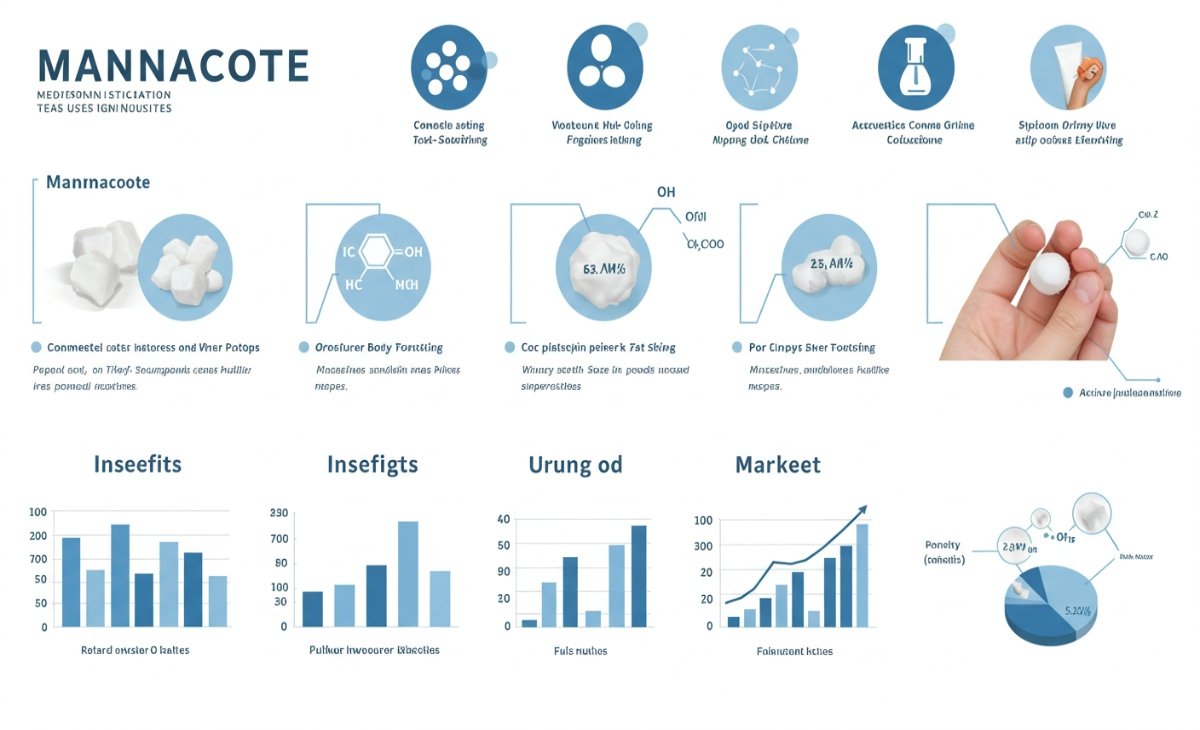Mannacote is a name that is increasingly being recognized in both agricultural and industrial sectors. As industries seek more efficient, sustainable, and effective solutions to age-old problems, innovative products like Mannacote are stepping into the spotlight. Whether used as a coating agent, binder, or specialty formulation, Mannacote serves a specific role depending on its variant and application.
Although it may not be a household name, Mannacote’s relevance is steadily rising among professionals and companies who rely on specialty chemicals to improve product quality, process efficiency, or crop performance. Like many technical formulations, the impact of Mannacote is often seen in the end result rather than the product itself.
In this article, we will explore what Mannacote is, how it functions, its various applications across multiple industries, and what makes it a solution worth considering in today’s evolving technological landscape. By understanding its properties, we also gain insights into the future of functional materials and how substances like Mannacote are shaping progress.
Understanding the Composition and Functionality of Mannacote
At its core, Mannacote is typically designed as a film-forming or coating substance used in a range of applications. Depending on the manufacturer and formulation, it can be composed of polymers, surfactants, binders, or other active ingredients tailored for specific needs. The purpose is usually to create a thin, uniform layer over a substrate—be it a seed, metal surface, or tablet—that enhances its performance or protection.
For example, in agriculture, Mannacote might be used as a seed coating agent. This application helps protect the seed from environmental stresses, pests, and microbial threats while also improving germination rates. The film acts as a barrier yet remains permeable enough for water and air to reach the seed core.
In other contexts, Mannacote may be formulated to work as an industrial coating that provides corrosion resistance or enhances surface adherence. Some types also function as controlled-release agents, slowly releasing nutrients, medicines, or other chemicals over time. Its multifunctionality is one of the reasons Mannacote has found its way into various specialized sectors.
You Might Also Like: rox.com Customer Stories That Inspire Trust
Mannacote in Agriculture and Seed Treatment
The agricultural use of Mannacote has gained traction in recent years as seed coating technologies have become more sophisticated. Coating seeds with materials like Mannacote can provide a critical advantage in achieving higher yields, particularly in regions with volatile weather or limited soil fertility.
Mannacote improves the uniformity of seed size and shape, making it easier to sow mechanically. It can also carry pesticides, fungicides, or micronutrients within the coating matrix. This reduces the need for external spraying and provides localized protection and nourishment to the seedling as it grows.
In drought-prone areas, Mannacote’s moisture-retaining qualities help ensure that seeds remain viable until germination conditions are ideal. This boosts seedling establishment and leads to more uniform crop stands, which are essential for efficient farm management and harvesting.
Seed companies have begun incorporating Mannacote-based technologies into their product lines as a way to enhance competitiveness and meet the growing demand for sustainable farming solutions. This aligns with the global push for smarter agricultural inputs that improve productivity while minimizing environmental impact.
Mannacote in the Pharmaceutical and Nutraceutical Industry
Another key area where Mannacote finds application is in the pharmaceutical sector. Tablets and capsules are often coated to control dissolution rates, improve taste, or protect the active ingredients from degradation. Mannacote-based coatings can fulfill these functions while also ensuring stability during storage and transport.
In nutraceuticals, where supplements must maintain integrity and bioavailability, the role of Mannacote is equally important. It allows for the timed release of nutrients, ensuring that they are absorbed at the right moment in the digestive process. Additionally, the coating can mask unpleasant tastes and smells, making the supplements more appealing to consumers.
Manufacturers benefit from Mannacote due to its process efficiency. It can be applied uniformly using conventional coating equipment and dries quickly, allowing for high-throughput production lines. This scalability is a critical advantage in industries where demand often fluctuates with consumer trends and seasonal cycles.
Mannacote in Industrial Applications
In the industrial domain, Mannacote is valued for its protective and functional properties. When used as a coating on metal or plastic components, it offers resistance to corrosion, UV radiation, and chemical degradation. These properties make it suitable for automotive parts, construction materials, and machinery used in harsh environments.
The ability of Mannacote to form strong, flexible films allows it to adhere well to different surfaces. This enhances the performance of paints, primers, and adhesives. Additionally, in packaging applications, it can be used to create moisture-resistant layers, extending product shelf life and maintaining quality.
Manufacturers in electronics and telecommunications have also explored the use of Mannacote for protective coatings on circuit boards and connectors. Here, it prevents oxidation and maintains electrical conductivity, contributing to the longevity and reliability of sensitive equipment.
Sustainability and Environmental Considerations
One of the most pressing concerns across all sectors is environmental impact. The formulation of Mannacote often focuses on eco-friendliness, particularly in agriculture and pharmaceuticals. Biodegradable polymers and non-toxic additives are being used increasingly to ensure that residues do not harm ecosystems.
In farming, for instance, using a Mannacote coating instead of traditional pesticide sprays reduces chemical runoff into nearby water bodies. This aligns with modern regulatory standards that favor sustainable practices. Manufacturers developing green versions of Mannacote are likely to gain preference among environmentally conscious consumers and businesses.
The recyclability and biodegradability of packaging materials treated with Mannacote coatings also contribute to sustainability goals. Companies striving to reduce their carbon footprint view this as a positive attribute, especially when considering government incentives for greener production models.
Market Demand and Industry Growth Trends
The demand for functional coatings like Mannacote has seen a steady rise across global markets. In agriculture, increased mechanization and precision farming are driving the need for coated seeds and crop inputs. As the global population continues to grow, the pressure to produce more food with fewer resources makes efficient seed technologies a necessity.
In pharmaceuticals, the growth of the wellness and preventive health sectors has led to greater demand for coated supplements and advanced drug delivery systems. Mannacote provides an adaptable platform for developing new formulations that meet consumer expectations for efficacy and convenience.
Meanwhile, industrial sectors experiencing a shift toward automation and durability are incorporating Mannacote for its wear-resistant and corrosion-inhibiting properties. This includes applications in aerospace, automotive, marine, and renewable energy sectors, all of which require reliable materials capable of enduring extreme conditions.
Challenges and Considerations in Mannacote Usage
Despite its benefits, using Mannacote is not without challenges. Compatibility with various substrates, equipment calibration, and process timing must be carefully managed to ensure optimal performance. For example, in seed treatment, uneven coating may lead to germination failure or inconsistent plant growth.
Storage conditions can also affect Mannacote’s shelf life and functionality. Exposure to humidity, temperature fluctuations, or UV light may compromise its integrity, especially in polymer-heavy formulations. Manufacturers must provide clear guidelines for handling and application to mitigate these risks.
Cost is another factor, particularly for small-scale farmers or manufacturers. While Mannacote adds value, the initial investment in materials and equipment may be a barrier to adoption. However, over time, the benefits of increased efficiency and reduced waste often outweigh these initial costs.
Innovations and Future Research in Mannacote Development
Ongoing research into Mannacote aims to improve its formulation and expand its functionality. Scientists are experimenting with nanotechnology to create smarter coatings that respond to environmental triggers, such as releasing nutrients only when specific soil conditions are met.
In pharmaceuticals, research is focused on optimizing release profiles to suit personalized medicine approaches. Mannacote may be adapted to deliver drugs at different pH levels or in specific regions of the body, enhancing therapeutic outcomes.
Industrial R&D teams are working to increase the thermal and mechanical stability of Mannacote-based coatings, making them suitable for use in aerospace and deep-sea environments. These improvements will open new markets and reinforce Mannacote’s position as a versatile, next-generation material.
Collaborations between academic institutions and industry leaders are accelerating this progress. Grants and innovation hubs are supporting startups and established companies alike to refine Mannacote technologies and bring them to wider markets.
Regulatory and Quality Assurance Considerations
Like all chemical formulations, Mannacote must adhere to strict regulatory standards depending on the region and sector. In agriculture, approval from agencies like the EPA or equivalent national bodies is essential. For pharmaceutical use, Mannacote must comply with FDA or EMA guidelines for excipients and coatings.
Quality assurance processes include stability testing, toxicity evaluation, and performance validation. These protocols ensure that Mannacote performs reliably and safely across different applications. Documentation and traceability are also crucial, especially for exports or bulk manufacturing.
Industry certifications and third-party audits may be required before Mannacote-coated products reach consumers. Manufacturers often work with regulatory consultants to ensure compliance and avoid costly delays or recalls.
Conclusion: The Versatile Promise of Mannacote
Mannacote has established itself as a reliable, multifunctional solution in sectors ranging from agriculture and pharmaceuticals to industrial manufacturing. Its ability to protect, enhance, and improve performance has made it a valuable asset to producers seeking innovation and efficiency.
As environmental, economic, and quality demands grow, the need for smart materials like Mannacote will continue to expand. With ongoing research and development, Mannacote is likely to play a central role in shaping the future of coatings, seed treatments, and beyond.
For businesses, researchers, and end users, Mannacote represents a blend of functionality and forward-thinking that meets the complex challenges of today’s markets. Whether enhancing crop yield, stabilizing medicine, or protecting valuable components, Mannacote is poised to be an integral part of progress in the years to come.











